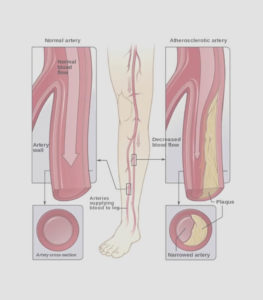
PERIPHERAL ARTERY DISEASE
Peripheral Artery Disease
Peripheral artery disease (PAD) is a circulatory condition in which the arteries that carry blood from the heart to the rest of the body become narrowed or blocked. This can reduce or prevent oxygen-rich blood from reaching the limbs and other organs, leading to a range of symptoms such as cramping, pain and numbness in the legs while walking, poor wound healing and skin discoloration. The primary cause of PAD is atherosclerosis—the buildup of plaque inside artery walls that narrows them and restricts blood flow.
Risk Factors
Risk factors for PAD include smoking, diabetes, high cholesterol, high blood pressure and family history. Treatment for PAD can include lifestyle changes such as quitting smoking, eating a healthy diet rich in fruits and vegetables, exercising regularly and controlling diabetes. Medications may also be prescribed to manage risk factors such as cholesterol or high blood pressure. In more severe cases where lifestyle changes are not enough to improve symptoms, surgery may be recommended to open blocked arteries or bypass them entirely with healthy vessels taken from other parts of the body.
Although peripheral artery disease can affect anyone regardless of age or gender, it is most common among people over 50 who have risk factors such as diabetes or high cholesterol levels. It’s important to talk to your doctor if you experience any signs or symptoms associated with PAD so they can develop an appropriate treatment plan for you.
